Hello Engineers. Glad to see you again on this website. Often, to the graduated, Beginner, hobbyist, or sometimes teachers, a common question is being asked. The question is, ” What are differences in Current Voltage and Power? OR, What is the difference between Current and Voltage? Or sometimes, beginners also struggle in starting with understanding the difference between Current Voltage and Power. So, I thought today, for some of my visitors to make a post explaining everything detailed. This post explains in detail about Resistance, Current, voltage, and power with the help of some real-life examples, demonstrations, and info-graphics. Also, how resistance, current voltage, and power are related to each other. What electrons have to do? The behavior of electrons and current voltage and power.
Before Jumping to the actual definitions or things, let’s first discuss about some basics.
What are Electrons?
Electrons are negatively charged subatomic particles that revolve around ( orbit ) the nucleus of an atom. They are actually negatively charged particles of an atom and are universal fundamental unit for a negative charge. In an atom, electrons reside in a spherical shell of different radius and the size of the shell shows different energy levels. Electrons can either be free or they can be bound to the nucleus.
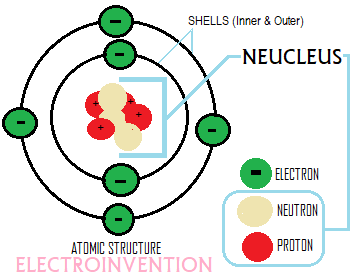
In real, electrons are much smaller in size as compared to nucleus of an atom.
Neutrons are neutral( without charge), protons are positive charges (+) and electrons have negative charges (-).
A positive charge of proton equals a negative charge of electron.
One electron volt is the energy that an electron gains when it travels through a potential difference of one volt (1 eV = 1.6 x 10-19 Joules).
Electron Flow:- Electron flow or flow of electron is the electron current. Electrons in a battery, flow from the negative(-) to positive(+) side. Whereas in just normal ‘Current electrons flow from positive+ to the negative side – (outside battery). This what actually happens, Electrons move from negative of the battery towards Positive.
What is Current?
We Know the Basic definition of current we have studied in books. Usually, Current is the flow of electrons through a conductor. OR,
Electric current can be defined as the rate of flow of Charge carrying negatively charged electrons or positively charged protons. It is also the rate of flow of charge from a point through a wire per unit time.
Current or conventional current is just the assumption of how current flows out through circuit,i.e from battery positive towards the battery negative, this was actually discovered when electricity was found. But actually it’s incorrect. Electron Flow is the real thing that actually happens.
Both concepts are used and if you talk about textbooks, then many textbooks are having half explainations.
The Letter ‘I’ is universal to denote the current in a circuit. The universal SI unit of electric current is Ampere and written as ‘A’.
The Electron Current is always in reverse to the Conventional current in a circuit. And, electron flow is the thing that actually happens.
Types Of Currents
Basically, there are 2 main types of currents:-
- Alternating Current [AC]:- Alternating Current is a type of electrical current in which the flow of electrons switch the directions with a regular time interval. Or we can say, it’s kind of electrical current that has alternating polarity. Like switching between positive and negative.
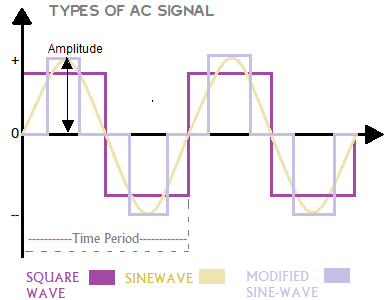
There are three types of AC Current with different Waveforms. They are Pure Sinewave/ sinewave AC Signal, Square Wave Signal, Modified Sinewave Signal.
Usually, Pure sinewave signal is what we get in our homes and industries from Electricity Substations. Pure sinewave/ sinewave AC is the purest form of AC current that can be naturally obtained from AC Dynamos and Generators.
Square wave AC signal is what we get from Astable Oscillators, Mostly Common and old fashioned or small purpose inverters. It’s not a pure form of AC.
Modified Sinewave Signal is also what most of the inverter devices give. It’s actually not pure AC signal but still its improved waveform and is chopped and trimmed, by either using PWM pulse or chopper circuit.
In an AC signal, The signal keeps changing polarity with a regular time interval which is called frequency. Frequency is the number of cycles in 1 second.
- Direct Current[DC]:- Direct current or DC is the type of electricity that is unidirectional and polarity is in a constant direction. Usually, we get DC from Batteries, and some DC dynamos, as well as output from a rectifier circuit, are also DC. A DC signal can be stored in batteries or capacitors or anywhere, while AC can’t be stored.
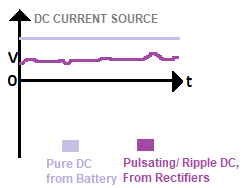
Both AC and DC are useful in their own scope of requirements and usage.
What is Resistance?
Resistance is the opposition to the flow of current or Electric charge. Resistance is the measure of resistivity of a substance to the flow of electric charge. It is measured in ‘Ohms’ (Ω).
Its symbol and unit were given after a german scientist named, Greg Simon Ohm. He was a German physicist who studied the relationship between the voltage current and resistance.
Resistance is the ratio of length of wire and cross-section area of the conductor/ wire/ Resistor. i.e

The resistance of a conductor depends upon its material, temperature length and area of cross section.
Resistivity is a term that is a property of a material that specifies the resistance offered by a certain material. It is denoted by ‘p’.

Resistance is also = Voltage / Current, i.e R=V/I. That is, defining relationship between Voltage, resistance and Current.This we’ll discuss later in this post.
What is Voltage?
Voltage is a term used to define an Electric potential difference between two points in a circuit. Voltage is the pressure at which charged electrons/ current travels through a circuit. In other words, we can say that Voltage is pressure or speed at which charges flow through a conductor or circuit loop through the load, such as an LED.
Its SI unit is Volts(V). This was due to the name of an Italian Physicist named Alessandro Volta, who discovered the first-ever electric cell. Usually,we can say Voltage=pressure/ force.
Earlier, the voltage was also said to be an electromotive force (emf). This is why in equations such as Ohm’s Law, voltage is represented by the symbol E.
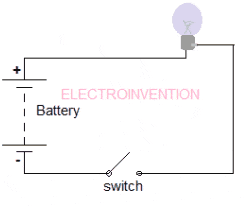
When, in a circuit, the switched is turned ON, the voltage from the power source’s two terminals generates a pressure, that forces the electrons to flow as the current through the battery’s negative terminal. As shown in the GIF format simulation.
Voltage are usually of two main types:
- AC current Voltage: AC voltage is the voltage from an AC electricity source, it is the voltage that drives the AC current. The voltage which we get on our domestic or industrial supply from electricity substations is AC voltage. AC voltage that we get from the electricity board to our houses is according to the country-specific standards.like some countries use 220v while some 110volts AC.
This voltage during one complete cycle of AC, goes to +220v an down to -220v , which are called as negative and positive cycles.
- DC Voltage:- It is what we get from batteries and some DC dynamos. They are constant in direction and amplitude.
Ohm’s Law and Relationship with voltage, current, resistance
The relationship between Voltage, Current, and resistance is defined by a Law, which we call Ohm’s Law. It is a Law discovered by a great German Physicist Greg Simon Ohm, which was named after him.
Ohm’s law states that the flow of current is directly proportional to the voltage(potential difference) and is inversely proportional to the resistance.
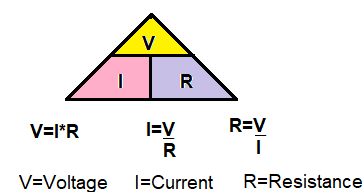
I=V/R. If the voltage increases, the current is increased. And, if the resistance increases, current decreases.
You may want to check Online Ohm’s law calculator. To verify the equations and help you calculate too.
Understanding Ohm’s Law and Voltage current and resistance with Real Life example
Just like, for example,
A pipeline attached with a water tap. When you open tap full, pressure(voltage) increases in resulting with more water(electrons/current) flow.
When you slightly turn the tap to slow the water, the tap cork obstructs(resistance), the water(electron) flow is also reduced. So, This real-life example is helpful for us to understand Ohm’s Law, as well as the relationship between Voltage, current, and resistance with electrons.
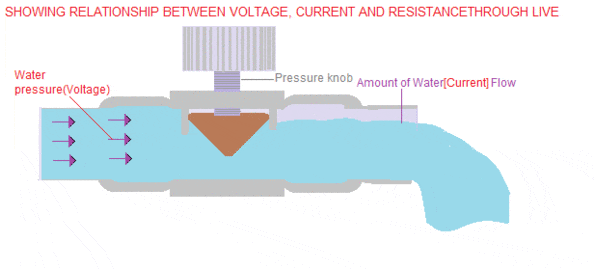
In the above GIF format Simulation, I have explained how voltage, current, and resistance are related to each other and with a real-life example of water tap and pipe line.
In this, the amount of water flow is flow of electron, or current. The pressure of the water flow, i.e speed, is Voltage.
Whenever, the pressure knob of the tap is a little bit closed or turned to slow water, the cork comes to obstruct the water. This is the obstruction offered to the flow of electrons by the resistance.
While the pressure knob is turned in opposite direction to increase water pressure(pressure=voltage). so also more amount of water flows(more current starts flowing in a given time).
This was how they are related, hope now every thing is really clear.
Power- What is Power?
So now, after you have understood the about voltage, current and resistance relationship, difference, as well as behavior of Electrons flow exhibited during the charge flow and obstruction. Let us now talk about Power. What is Power. What is difference between watts and volts?
Basically, Power is a product of Voltage(Potential difference) and Current flowing through a circuit. Also, power is amount of energy transmitted or applied per unit time (as per defination i physics).
The International Standard (SI) unit of power in watts. 1 watt of power is equal to 1 joule per second. Power is also work/time. And, power is a scalar unit.
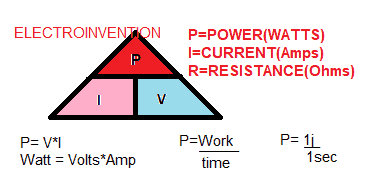
With respect to electricity, power is the rate per unit time, at which electrical energy is transferred through a circuit. However, energy is what we refer to as energy consumed per unit time and electrical power is the transfer of electrical energy per unit time.
Also try this Online Electrical power Calculator by Electroinvention.
POWER REQUIREMENT: Power Requirement or power ration of an electrical/electronic device is the amount of power required by an electrical device. It’s usually in watts, and for electrical Motors and pumpsets, its usually in both, Watts and Horsepower. Horse power or power rated can be both required as well as generated power.
1 horsepower = 746 watts of electrical power.
For example, a pump rated for 1 horsepower means it is required power by a pump, i.e equal to 1 horsepower or 745 watts, if the pump is ideal 100 percent efficient. Usually, it’s a bit more as nothing is that efficient. 1 horsepower also means to drive 550 foot-pounds per second, that is also the power a horse can provide.
POWER Factor (PF): Power Factor in electrical/electronics engineering is the ratio of power actually consumed by any Load to the apparent or rated power or power that is used to run a particular machine.
In other language, its the ratio of actual power consumed(Kw) to the apparent or running power(KvA).

This difference between the two is due to the resistance offered and other factors like heat dissipation, etc.
So guys I hope You people liked this article, for more such articles and Circuit projects, Subscribe To our Newsletter. Also, do comment below about the article.
Share this articles with your friends, teachers, and classmates. Thank You


thanks
well explained very nice thsnks
Cool bro, thanks
Hello raj thanks for visiting and glad you liked it
One of the best article so far, all the aspects of current and electricity is well explained with the proper examples and easily understandable graphic contents. All the basics like Voltage, Current,power,Power factor and most important points like conventional flow of electrons V/s actual flow of current is explained (it would have been better if you could have elaborated this topic a bit more, but still pretty descent information is given). I would love to see the extension of this article, in your next blog please cover the topics like
1)conventional flow of electrons V/s actual flow of current
2)magnetic effect of electric current
3) Electromagnetism . (will be eagerly waiting to see the extension).
over this article was electrifying keep up the good work Abishek sharma 🙂
Hello Rishi, Good to see you here again. Thanks for the appreciation and glad you liked it. Yeah for sure in future I’ll put one post on electromagnetism as well.